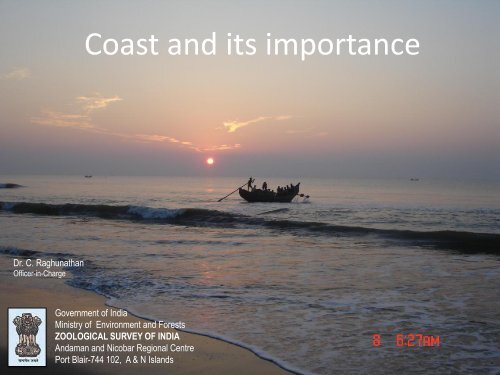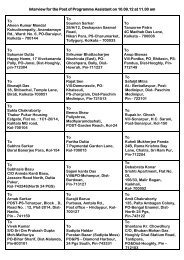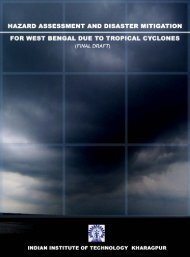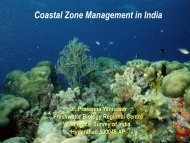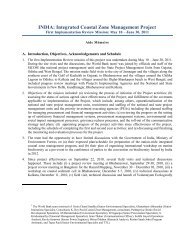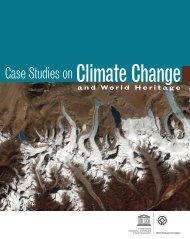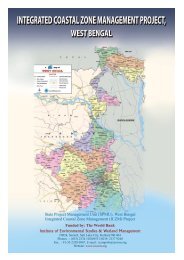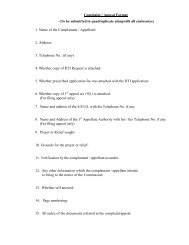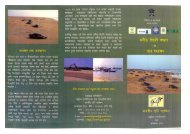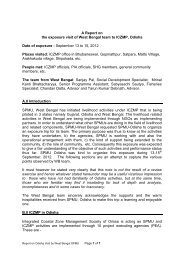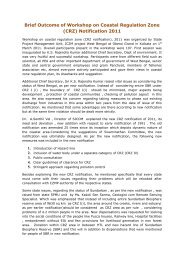What is a coast and its importance - Iczmpwb.org
What is a coast and its importance - Iczmpwb.org
What is a coast and its importance - Iczmpwb.org
You also want an ePaper? Increase the reach of your titles
YUMPU automatically turns print PDFs into web optimized ePapers that Google loves.
Coast <strong>and</strong> <strong>its</strong> <strong>importance</strong><br />
Dr. C. Raghunathan<br />
Officer-in-Charge<br />
Government of India<br />
Min<strong>is</strong>try of Environment <strong>and</strong> Forests<br />
ZOOLOGICAL SURVEY OF INDIA<br />
Andaman <strong>and</strong> Nicobar Regional Centre<br />
Port Blair-744 102, A & N Isl<strong>and</strong>s
Coast<br />
Coasts are dynamic interface zones<br />
of the atmosphere, l<strong>and</strong> <strong>and</strong><br />
sea.<br />
About 50% of the world’s population<br />
lives in within 200km of the<br />
shoreline.<br />
Sea<strong>coast</strong> attracts for their moderate<br />
climate, seafood, recreational<br />
opportunities, transportation,<br />
commercial establ<strong>is</strong>hments,<br />
trade, tour<strong>is</strong>m etc.<br />
V<strong>is</strong>hakhapatnam <strong>coast</strong><br />
Chennai <strong>coast</strong>
Top 10 largest <strong>coast</strong>al cities of the world<br />
1. Tokyo, Japan - Coastal<br />
2. Mexico City, Mexico – Inl<strong>and</strong><br />
3. Mumbai, India – Coastal<br />
4. Sao Paulo, Brazil – Inl<strong>and</strong><br />
5. New York, USA – Coastal<br />
6. Shanghai, China – Coastal<br />
7. Lagos, Nigeria – Costal<br />
8. Los Angeles, USA – Coastal<br />
9. Kolkata, India – Coastal<br />
10. Buenos Aires, Argentina - Coastal<br />
Coastal city - Chennai
Coastal Terminology<br />
Shore: Zone lies between the lowest tide level <strong>and</strong> the <strong>coast</strong>line<br />
Foreshore: Portion of area exposed at low-tide <strong>and</strong> submerged at<br />
high-tide (= intertidal zone)<br />
Backshore: Extends beyond normal high tide to the <strong>coast</strong>line<br />
Nearshore: Region between the low-tide shore <strong>and</strong> breakers<br />
Offshore: Region beyond the low-tide breakers<br />
Beach: Sediment deposit on the shore area
Terminology of <strong>coast</strong>al regions
Zones which influence the <strong>coast</strong>al <strong>and</strong> marine gamut<br />
Inl<strong>and</strong> areas: Affects the ocean<br />
mainly via rivers <strong>and</strong> streams<br />
Coastal l<strong>and</strong>s: Wetl<strong>and</strong>s, marshes,<br />
<strong>and</strong> place where human activity<br />
<strong>is</strong> concentrated <strong>and</strong> directly<br />
affects adjacent waters<br />
Coastal waters: Generally estuaries,<br />
lagoons, backwaters, shallow<br />
waters etc. where the effects of<br />
l<strong>and</strong> based activities are<br />
dominant.<br />
Offshore waters: Mainly to the edge<br />
of national jur<strong>is</strong>diction i.e. 200<br />
nautical miles<br />
High Seas: Sea beyond the<br />
offshore waters<br />
Offshore waters of Chennai
Tides<br />
Definition: The periodic r<strong>is</strong>e <strong>and</strong> fall of the<br />
level of the sea over a given time<br />
interval <strong>is</strong> called tide.<br />
Diurnal tides: Locations having single low<br />
<strong>and</strong> high tides per day<br />
Semi-diurnal tides: Those with two high<br />
<strong>and</strong> low tides per day.<br />
Mixed tides: The height of the low <strong>and</strong> high<br />
tides varies from day to day as the<br />
positions of the sun <strong>and</strong> moon change<br />
relatively each other.<br />
Spring tides: Tides with a large range occur<br />
in lunar days.<br />
Neap tides: Tides with a small range that<br />
occur when the moon <strong>is</strong> in quarter
Coastal environment of India<br />
Coastline: 7600 km long with maritime states viz. Gujarat,<br />
Maharashtra, Goa, Karnataka, Kerala, Tamil Nadu, Pondicherry<br />
(UT), Andhra Pradesh, Or<strong>is</strong>sa, West Bengal <strong>and</strong> Isl<strong>and</strong>s of<br />
Andaman & Nicobar; <strong>and</strong> Lakshadweep.<br />
Coastal Belt: Out of the total l<strong>and</strong>mass of 3.28 million sq.km., nearly<br />
0.15 million sq.km. <strong>is</strong> <strong>coast</strong>al belt.<br />
Rivers: 14 major, 44 medium <strong>and</strong> 55 minor rivers that d<strong>is</strong>charge<br />
15,66,000 million cubic metres of freshwater in to the sea.<br />
Among the 14 major rivers, 9 debouches in to Bay of Bengal <strong>and</strong> 5<br />
confluence in Arabian Sea.
Coastal Environment of India – Contd.<br />
Coastal population: 212.5 × 10 6<br />
Territorial waters: 0.13 million sq.km.<br />
EEZ: 2.015 million sq. km.<br />
Mangroves: 4639 sq.km.<br />
Estuaries: 3900 sq.km.<br />
Mudflat: 2961 sq.km.<br />
Coastal dunes: 2509 sq. km.<br />
Saltpans: 1617 sq. km.<br />
Lagoon <strong>and</strong> Backwaters: 2132 sq.km.<br />
River runoff: 1545 cubic km. per day<br />
No. of major <strong>coast</strong>al industries: 450 (West <strong>coast</strong> – 232; East <strong>coast</strong> – 218)
Indian <strong>coast</strong>al facilities<br />
Ports <strong>and</strong> Harbors<br />
• Major ports: 11<br />
• Intermediate ports: 16<br />
• Minor Ports: 78<br />
• Ship v<strong>is</strong>it: 10,000 per year<br />
F<strong>is</strong>hing Harbors<br />
• Major: 6<br />
• Minor: 35<br />
• F<strong>is</strong>h l<strong>and</strong>ing centres: 135
Types of Shores<br />
• Rocky Shore<br />
• S<strong>and</strong>y Shore<br />
• Muddy Shore
Rocky Shore<br />
• Intertidal area of sea<strong>coast</strong> where<br />
solid rocks predominates.<br />
• Biologically rich environment.<br />
Zonation<br />
• Supra-littoral fringe, Mid-littoral<br />
Zone, Infra-littoral fringe (Sublittoral<br />
zone)<br />
Factors affecting animals<br />
• Wave action – sessile, filter<br />
feeding (barnacles, mussel, oyster<br />
etc.)<br />
• Desiccation & Water loss –<br />
Operculum (gastropods) <strong>and</strong><br />
valves (oysters <strong>and</strong> mussels)<br />
• Temperature <strong>and</strong> Salinity – Hard<br />
Shells to tolerate heat (molluscs),<br />
hide in crevices of rock (crab,<br />
sponges)
Rocky shore animals<br />
Sea urchin<br />
Turbo<br />
Zoanthid<br />
Rock oyster
S<strong>and</strong>y Shore<br />
• A s<strong>and</strong>y beach <strong>is</strong> made up of minute<br />
grains of s<strong>and</strong> or crushed shells <strong>and</strong><br />
rock.<br />
• S<strong>and</strong>y shores are exciting places with<br />
life in <strong>and</strong> underneath the water.<br />
Factors affecting animals<br />
• Wave action – Organ<strong>is</strong>ms burrow deeply<br />
<strong>and</strong> live in it – bivalves, shore crabs,<br />
annelids etc.<br />
• S<strong>and</strong> dollars (echinoderm) accumulates<br />
iron compounds in a special area of<br />
their digestive tract <strong>and</strong> the iron serves<br />
as a weight belt to keep them down in<br />
the presence of wave action.<br />
• Animals buried themselves during day<br />
time in order to avoid heat.
S<strong>and</strong>y shore Molluscs<br />
Oliva<br />
Donax<br />
Dentallium<br />
Cypraea
S<strong>and</strong>y shore habitat in intertidal zone
Adaptation of animals in s<strong>and</strong>y shore
S<strong>and</strong>y shore animals
Zonation in S<strong>and</strong>y Shore
Muddy Shore<br />
• Muddy shores, with their finer<br />
sediment, have smaller interstitial<br />
spaces <strong>and</strong> these trap <strong>org</strong>anic<br />
matter.<br />
• Smaller spaces means that drainage<br />
when the tide drops <strong>is</strong> less <strong>and</strong> so<br />
muddy shores hold on to their<br />
water.<br />
• Anaerobic condition in the muddy<br />
shore prevails as the exchange of<br />
interstitial water <strong>is</strong> very poor due to<br />
vey fine particle size of the s<strong>and</strong><br />
grain.<br />
• Due to the growth of bacteria,<br />
complete depletion of oxygen in the<br />
interstitial area.<br />
• Supra-littoral zone of muddy shore<br />
normally mangroves could be seen
Grain size in muddy shore
Water flow circulation in muddy shore sediment
Adaptation of animals in muddy shore<br />
• Burrowing into the mud <strong>and</strong><br />
feeds through long siphonal<br />
canal – Cockles <strong>and</strong> Clams<br />
• Making ‘U’ shaped burrow –<br />
Arenicola <strong>and</strong> other polychaetes.<br />
One arm of U <strong>is</strong> remained open<br />
for deposit feeding.<br />
• Muddy shore animals are mud<br />
crabs, fiddler crabs, oysters,<br />
bivalves,<br />
gastropods<br />
(Telescopium, Cerithium etc.)<br />
annelid worms, f<strong>is</strong>hes-mud<br />
skipper <strong>and</strong> mud snapper etc.
Muddy shore animals<br />
Epifauna <strong>and</strong> infauna
Coastal Ecosystems<br />
• Estuarine ecosystem<br />
• Lagoon ecosystem<br />
• S<strong>and</strong> dune ecosystem<br />
• Salt marsh ecosystem<br />
• Seagrass <strong>and</strong> seaweed ecosystems<br />
• Mangrove ecosystem<br />
• Coral reef ecosystems
Estuarine ecosystem<br />
• Estuaries are semi-enclosed area<br />
where freshwater <strong>and</strong> seawater<br />
meet <strong>and</strong> mix.<br />
• Estuaries are subject to wide<br />
fluctuations in salinity<br />
• Normally salinity of estuary ranges<br />
from 0 to 35 ppt.<br />
Adyar estuary<br />
• Major estuaries in India are<br />
Hoogly, Mahanadhi, Godavari,<br />
Kr<strong>is</strong>hna, Coleroon, Vellar on the<br />
east <strong>coast</strong> <strong>and</strong> Narmada, Tapi,<br />
M<strong>and</strong>ovi <strong>and</strong> Zuari estuaries on<br />
the west <strong>coast</strong>
Profile of an ideal estuary
Adaptations of an estuarine animals<br />
• Euryhaline: Species can<br />
tolerate wide range of<br />
salinity<br />
• Stenohaline: species<br />
can tolerate only<br />
narrow range of salinity<br />
• Migration: Anadromus<br />
(salmon, smelts, shad)<br />
<strong>and</strong> Catadromous (Eel)<br />
for spawning purposes
Importance of Estuaries<br />
• Provides a nursery for the larval forms of some marine f<strong>is</strong>h species, <strong>and</strong> shelter <strong>and</strong> food for<br />
many young <strong>and</strong> adult f<strong>is</strong>h <strong>and</strong> shellf<strong>is</strong>h.<br />
• Provides rich feeding grounds for shore birds<br />
• Serving as important habitats for wildlife<br />
• Estuarine plants also can absorb tide <strong>and</strong> storm surges, providing ideal habitats for wildlife<br />
• Th<strong>is</strong> natural buffer helps to prevent erosion <strong>and</strong> stabilize the <strong>coast</strong><br />
• Yields commercially important f<strong>is</strong>hery including prawns <strong>and</strong> crabs.<br />
• Provide safe habours for shipping<br />
• Tour<strong>is</strong>m
Seagrass <strong>and</strong> Seaweed Ecosystems<br />
Seagrass<br />
• Seagrasses occur in the shallow subtidal<br />
regions of sheltered localities of the sea,<br />
gulf, bays, backwaters <strong>and</strong> lagoon.<br />
• Grow in mud flats <strong>and</strong> s<strong>and</strong>y regions.<br />
• They are submerged monocotyledonous<br />
plants adapted to marine environment for<br />
completion of their life cycle under water.<br />
• They occur along the east <strong>and</strong> west <strong>coast</strong> of<br />
Indian peninsula <strong>and</strong> Andaman <strong>and</strong> Nicobar<br />
Isl<strong>and</strong>s.<br />
• Occur along 5-15m depth in Indian <strong>coast</strong><br />
• However, they can grow at more than 32<br />
meters depth. In clear water condition, they<br />
even grow at the depth of 65 meters<br />
Seagrass meadow, Andaman<br />
Dugong dugon
Diversity of seagrass<br />
• Global composition ranges from 0.1 to 0.2% of<br />
the aquatic flora<br />
• 60 species described from world oceans<br />
• 14 species reported from India (Cymodacea rotundata,<br />
Cymodocea serrulata, Enhalus acoroides, Halodule pinifolia, H. uninerv<strong>is</strong>,<br />
H. whitii, H. beccarii, H. decipiens, H. oval<strong>is</strong>, H. ovata, H. stipulacea,<br />
Syringodium <strong>is</strong>oetifolium <strong>and</strong> Thalassia hermprichi)<br />
• Gulf of Mannar – 13 species<br />
• Andaman <strong>and</strong> Nicobar Isl<strong>and</strong>s – 9 species
Significance of seagrass<br />
• Provide a habitat for Dugong dugon, only herbivorous marine mammal ex<strong>is</strong>t.<br />
• Also provide habitats for a wide variety of marine <strong>org</strong>an<strong>is</strong>ms, both plant <strong>and</strong><br />
animal; these include meiofauna <strong>and</strong> flora, benthic flora <strong>and</strong> fauna, epiphytic<br />
<strong>org</strong>an<strong>is</strong>ms, plankton <strong>and</strong> f<strong>is</strong>h, not to mention microbial <strong>and</strong> parasitic <strong>org</strong>an<strong>is</strong>ms.<br />
• Feeding ground for dugongs, turtles, f<strong>is</strong>hes <strong>and</strong> sea urchins<br />
• Extraordinarily high rate of primary production.<br />
• Serve as a f<strong>is</strong>hing ground, wave protection, oxygen production <strong>and</strong> protection<br />
against <strong>coast</strong>al erosion.<br />
• Seagrass meadows account for 15% of the ocean’s total carbon storage. The ocean<br />
currently absorbs 25% of global carbon em<strong>is</strong>sions<br />
• It <strong>is</strong> estimated that seagrasses per square meter are capable of binding about<br />
1000grams of carbon, every year.
Threats to seagrass ecosystem<br />
Natural threat<br />
• Damage to seagrass groups <strong>is</strong> mostly due to climatic changes, global warming which in turn refers<br />
to changes in oceans salinity levels, shift in water quality, increase in sea surface temperatures,<br />
frequency of natural d<strong>is</strong>asters, <strong>and</strong> more.<br />
• Seagrasses are in global decline, with some 30,000 km 2 (12,000 sq mi) lost during recent decades.<br />
Anthropogenic threat<br />
• Coastal activities such as ports, harbours, construction, garbage dumps, urban pollution, industrial<br />
dumps, terrestrial erosion, <strong>coast</strong>al development, breakwaters, f<strong>is</strong>h farming, aquaculture,<br />
eutrophication, siltation, dredging, anchoring, are taking heavy toll on the fragile plants.<br />
Pollution<br />
• Excessive input of nutrients (nitrogen, phosphorus) <strong>is</strong> directly toxic to seagrasses, but most<br />
importantly, it stimulates the growth of epiphytic <strong>and</strong> free-floating macro- <strong>and</strong> micro-algae. Th<strong>is</strong><br />
weakens the sunlight, reducing the photosynthes<strong>is</strong> that nour<strong>is</strong>hes the seagrass <strong>and</strong> the primary<br />
production results
Seaweeds<br />
• Seaweeds or marine algae prefer<br />
flat <strong>and</strong> rocky <strong>coast</strong> gradually<br />
slope towards the sea with a<br />
marked tidal effect.<br />
• D<strong>is</strong>tributed from intertidal to<br />
subtidal region of lagoons, bay,<br />
rock pools, creeks of the <strong>coast</strong>.<br />
• India, seaweeds are d<strong>is</strong>tributed in<br />
west <strong>coast</strong>, Andaman <strong>and</strong><br />
Nicobar Isl<strong>and</strong>s, Lakshadweep<br />
<strong>and</strong> in east <strong>coast</strong> (abundant in<br />
Chilka <strong>and</strong> Gulf of Mannar)<br />
Gracillaria sp.<br />
Turbinaria sp.<br />
• 559 species of seaweeds are<br />
reported from India
Seaweed resources in Indian Coast<br />
State<br />
Annual yield (in<br />
tonnes)<br />
Gujarat 19,000 to 1,00,000<br />
Maharashtra 20,000<br />
Goa 2,000<br />
Tamil Nadu 28,550<br />
Lakshadweep 3645-7589
Importance of seaweeds<br />
Food<br />
• Seaweeds are consumed by <strong>coast</strong>al people, particularly in Japan, China, Korea, Taiwan, Phillippines,<br />
Thail<strong>and</strong>, Cambodia, Vietnam, South Africa, Indonesia, Peru, Chile, Sc<strong>and</strong>inavia, Irel<strong>and</strong> <strong>and</strong> Scotl<strong>and</strong>.<br />
• Seaweeds are also harvested or cultivated for the extraction of alginate, agar <strong>and</strong> carrageenan<br />
• Agar <strong>is</strong> used in foods such as confectionery, meat <strong>and</strong> poultry products, desserts <strong>and</strong> beverages <strong>and</strong><br />
moulded foods.<br />
• Carrageenan <strong>is</strong> used in salad dressings <strong>and</strong> sauces, dietetic foods, <strong>and</strong> as a preservative in meat <strong>and</strong> f<strong>is</strong>h products,<br />
dairy items <strong>and</strong> baked goods.<br />
Medicine<br />
• Alginates are used in wound dressings, <strong>and</strong> production of dental moulds.<br />
• Agar <strong>is</strong> extensively used as culture medium.<br />
• Carrageenans, alginates <strong>and</strong> agaroses (the latter are prepared from agar by purification), together with<br />
other lesser-known macroalgal polysaccharides, also have several important biological activities or<br />
applications in biomedicine.<br />
• Seaweed <strong>is</strong> a source of iodine, necessary for thyroid function <strong>and</strong> to prevent goitre.<br />
• Seaweeds may have curative properties for tuberculos<strong>is</strong>, arthrit<strong>is</strong>, colds <strong>and</strong> influenza, worm infestations<br />
<strong>and</strong> even tumors.<br />
• Seaweed extract <strong>is</strong> used in some diet pills. Other seaweed pills exploit the same effect as gastric b<strong>and</strong>ing,<br />
exp<strong>and</strong>ing in the stomach to make the body feel more full.
Mangrove Ecosystem<br />
• Mangroves are tidal forest.<br />
• 100 species of true mangroves<br />
have been described from the<br />
world.<br />
• Mangrove vegetation<br />
represents trees, shrubs,<br />
herbs, climbers, epiphytes <strong>and</strong><br />
parasites.<br />
Mangroves, A&N Isl<strong>and</strong>s<br />
• Mangroves occur 112<br />
countries mainly in the tropical<br />
region of the world with an<br />
area of 1,89,399 sq.km.
Region-w<strong>is</strong>e d<strong>is</strong>tribution<br />
of mangroves<br />
Sl.<br />
No.<br />
Region<br />
Area<br />
(Sq. Km.)<br />
1. Southeast Asia 75,172 41.4<br />
2. America 45,096 27.1<br />
3. West Africa 27,995 15.4<br />
4. Australia 18,788 10.4<br />
5. East Africa <strong>and</strong><br />
Middle East<br />
10,348 5.7<br />
Total 1,81,399 100<br />
%<br />
Mangroves, A&N Isl<strong>and</strong>s
Sl.<br />
No.<br />
State-w<strong>is</strong>e status of mangroves in India<br />
State Area (Sq. Km.) No. of species<br />
1. Andhra Pradesh 353 31<br />
2. Goa 17<br />
3. Gujarat <strong>and</strong><br />
Daman &Diu<br />
1047 12<br />
4. Karnataka 3 29<br />
5. Kerala 5 27<br />
6. Maharashtra 186 26<br />
7. Or<strong>is</strong>sa 221 60<br />
8. Tamil Nadu &<br />
Pondicherry<br />
39 24<br />
9. West Bengal 2152 57<br />
10. Andaman <strong>and</strong><br />
Nicobar<br />
Total 4639<br />
615 44
Diversity of mangroves in India<br />
No. of species reported: 69 species<br />
under 42 genera <strong>and</strong> 27 families<br />
• East <strong>coast</strong>: 63 species<br />
• West Coast: 37 species<br />
• A & N Isl<strong>and</strong>s: 44 species<br />
Sonneratia alba<br />
Rhizopora apiculata
Mangrove fauna of India<br />
(2359 species)<br />
• Prawn: 55 species<br />
• Crabs: 138 species<br />
• Molluscs: 308 species<br />
• Insects: 711 species<br />
• F<strong>is</strong>hes: 546 species<br />
• Amphibians: 13<br />
species<br />
• Reptiles: 85 species<br />
• Birds: 433 species<br />
• Mammals: 70 species<br />
Mangrove trail, A&N Isl<strong>and</strong>s
Threatened species of f<strong>is</strong>hes in mangrove ecosystems of India<br />
Sl.<br />
No.<br />
Species Family IUCN Status<br />
1. Arius subrostratus Ariidae Vulnerable<br />
2. Boleophthalmus boddarti Gobiidae Vulnerable<br />
3. Boleophthalmus<br />
dussumieri<br />
Gobiidae<br />
Endangered<br />
4. Scartelaos virid<strong>is</strong> Gobiidae Endangered<br />
5. Peripthalmus koelreuteri Gobiidae Vulnerable<br />
6. Dasyat<strong>is</strong> uarnak Trygonidae Vulnerable<br />
7. Elops machnata Elopidae Vulnerable<br />
8. Leiognathus splendens Leiognathidae Vulnerable<br />
9. Muraenichthys schultzei Muraenidae Vulnerable<br />
10. Psammaperca waigiens<strong>is</strong> Centropomidae Vulnerable<br />
11. Secutor ruconius Leiognathidae Vulnerable
Threatened invertebrates in mangrove ecosystems of India<br />
Sl.<br />
No.<br />
Species Family IUCN Status<br />
1. Card<strong>is</strong>oma carnifex Gecarcinidae Critically<br />
endangered<br />
2. Gelonia erosa Gelonidae Endangered<br />
3. Macrophthalmus convexus Ocypodidae Endangered<br />
4. Meretrix casta Veneridae Vulnerable<br />
5. Penaeus canaliculatus Palaemonidae Vulnerable<br />
6. Penaeus japonicus Palaemonidae Vulnerable<br />
7. Pilodius nigrocrinitus Xanthidae Endangered<br />
8. Sesarma taeniolata Grapsidae Vulnerable<br />
9. Uca tetragonon Ocypodidae Endangered
Rare, endemic <strong>and</strong> restricted mangrove species in India<br />
1. Acanthus ebracteatus: Restricted to A&N<br />
2. Aegialit<strong>is</strong> rotundifolia: Confined to W.B., Or<strong>is</strong>sa <strong>and</strong> AP<br />
3. Aglaia cuculata: Restricted to W.B. <strong>and</strong> Or<strong>is</strong>sa<br />
4. Brownlowia tersa: Restricted to W.B., Or<strong>is</strong>sa <strong>and</strong> AP<br />
5. Heritiera fomes: Restricted to W.B. <strong>and</strong> Or<strong>is</strong>sa<br />
6. Heritiera kanikens<strong>is</strong>: Endemic to Bhitarkanika<br />
7. Lumnitzera littorea: Restricted to A & N<br />
8. Merope angulata: Confined to W.B. <strong>and</strong> Or<strong>is</strong>sa<br />
9. Nypa fruticans: Restricted to W.B. <strong>and</strong> A&N<br />
10. Phoenix paludosa: Restricted to A&N <strong>and</strong> AP<br />
11. Rhizophora annamalayana: Endemic to Pitchavaram<br />
12. Rhizophora stylosa: Confined to Or<strong>is</strong>sa<br />
13. Scyphiphora hydrophyllacea: Restricted to A&N <strong>and</strong> AP<br />
14. Sonneratia apetala: Rare in several areas<br />
15. Sonneratia griffithii: Restricted to W.B, Or<strong>is</strong>sa <strong>and</strong> A&N<br />
16. Tylophora tenu<strong>is</strong>: Restricted to W.B. <strong>and</strong> Or<strong>is</strong>sa<br />
17. Urochondra setulosa: Endemic to Gujarat<br />
18. Thespesia pipulneoides: Restricted to West Bengal <strong>and</strong> Or<strong>is</strong>sa<br />
19. Xylocarpus makongens<strong>is</strong>: Restricted to W.B., Or<strong>is</strong>sa, A&N<br />
20. Xylocarpus mollucens<strong>is</strong>: Restricted to A&N
Threats to Mangroves<br />
1. Cattle grazing: Tamil Nadu, Gujarat<br />
2. Exploitation for fire wood <strong>and</strong> wood:<br />
TN, GUJ<br />
3. Urbanization: Mumbai<br />
4. Reclamation for Agriculture: W.B,<br />
Or<strong>is</strong>sa, AP, Kerala<br />
5. Aquaculture: WB, AP<br />
6. Construction of bridges: WB, TN, AP,<br />
GUJ, MH<br />
7. Port <strong>and</strong> Harbour development: GUJ,<br />
WB, MH<br />
8. Hyper salinity: GUJ, TN, WB<br />
9. Siltation <strong>and</strong> Sedimentation: River <strong>and</strong><br />
l<strong>and</strong> run-off<br />
10. Natural calamities: Cyclone, Tidal<br />
waves (Tsunami)<br />
11. Pollution: industrial, pesticide, oil
Coral Reef Ecosystem
Acropora monticulosa<br />
Coral Reef Ecosystem<br />
• Restricted to warm seas, essentially between the tropics of Cancer <strong>and</strong> Capricorn, where<br />
minimum water temperature do not fall below 20ºC<br />
• Their occurrence limited to 0.2% of the ocean area on the earth’s surface, have globally<br />
important implication for their amazing marine biodiversity<br />
• Providing critical habitats to approximately 25% of marine <strong>org</strong>an<strong>is</strong>ms<br />
• Although various types of corals can be found from the water's surface to depths of 6,000 m,<br />
reef- building corals are generally found at depths of less than 46 m, where sunlight penetrates.<br />
• Massive corals grow from 0.5 cm to 2 cm per year. However, under favourable conditions (high<br />
light exposure, cons<strong>is</strong>tent temperature, moderate wave action), some species can grow as<br />
much as 4.5 cm per year. In contrast to the massive species, branching colonies can grow<br />
vertically by as much as 10 cm per year.
Global D<strong>is</strong>tribution of Coral Reefs<br />
Coral reef cover of the world <strong>is</strong> estimated as 600,000 km 2 (Smith, 1978;<br />
Klepays, 1997)<br />
Mediterranean Indian Ocean: 54% , Pacific Ocean: 25%, Atlantic Ocean: 6%<br />
Caribbean Sea: 9%, Red Sea: 4%, Persian Gulf: 2%
D<strong>is</strong>tribution of Coral Reefs in India<br />
Estimated coral cover in India <strong>is</strong> 5730 km 2<br />
Major reef areas are A&N Isl<strong>and</strong>s,<br />
Gulf of Mannar, Gulf of Katchchh,<br />
Lakshadweep , Malvan <strong>coast</strong> <strong>and</strong> Or<strong>is</strong>sa <strong>coast</strong>.
Diversity of Scleractinian Corals in A&N Isl<strong>and</strong>s <strong>and</strong> other reefs of India<br />
Sl No. Family A & N Isl<strong>and</strong>s Gulf of Mannar Lakshadweep<br />
Isl<strong>and</strong>s<br />
Gulf of Katchchh<br />
1. Astrocoeniidae 03 (02) 1(1) - -<br />
2. Pocilloporidae 14 (03) 3(1) 5(2) -<br />
3. Acroporidae 146 (04) 31(3) 28(3) 7 (2)<br />
4. Poritidae 39 (03) 10(2) 9 (3) 6(2)<br />
5. Siderasteridae 12 (04) 3(3) 4(1) 4(4)<br />
6. Agariciidae 28 (05) 5(2) 4(2) -<br />
7. Fungiidae 44 (11) 1(1) 6(4) -<br />
8. Oculinidae 04 (01) 2(1) 2(1) -<br />
9. Pectinidae 13 (04) 1(1) - 1(1)<br />
10. Mussidae 21 (05) 1(1) 3(3) 2(2)<br />
11. Merulinidae 08 (03) 2(2) 2(2) 1(1)<br />
12. Faviidae 82 (16) 20(9) 26(11) 13(7)<br />
13. Euphyllidae 07 (03) - 1(1) -<br />
14. Dendrophyllidae 08 (02) 2(1) 1(1) 2(1)<br />
15. Me<strong>and</strong>rinidae 01 (01) - - -<br />
16. Trachyphylliidae 01 (01) - - -<br />
17. Rhizangiidae - - - -<br />
18. Caryphyllidae 02 (02) - - -<br />
TOTAL 433 (72) 117(28) 104(34) 36(20)
Diversity of Corals in A&N Isl<strong>and</strong>s in compar<strong>is</strong>on with global report<br />
Sl. No<br />
Family<br />
World A&N Isl<strong>and</strong>s Approx. Depth<br />
(m)<br />
Genus Species Genus Species<br />
1 Acroporidae 4 275 4 146 2-35<br />
2 Astrocoeniidae 4 14 2 03 3-4<br />
3 Pocilloporidae 3 31 3 14 0.5-15<br />
4 Euphyllidae 5 16 3 07 5-18<br />
5 Oculinidae 4 15 1 04 0.5-20<br />
6 Me<strong>and</strong>rinidae 7 9 1 01 3-8<br />
7 Siderastreidae 6 29 4 12 4-13<br />
8 Agariciidae 6 45 5 28 2-15<br />
9 Fungiidae 13 56 11 44 1-25<br />
10 Rhizangiidae 2 2 - - -<br />
11 Pectiniidae 5 30 4 13 4-28<br />
12 Merulinidae 5 12 3 8 3-12<br />
13 Dendrophyllidae 5 18 2 8 2-15<br />
14 Caryphylliidae 1 1 1 2 3-9<br />
15 Mussidae 13 56 5 21 2-15<br />
16 Faviidae 24 132 16 82 0.5-30<br />
17 Trachyphylliidae 1 1 1 01 8-18<br />
18 Poritidae 5 84 3 39 0.5-20<br />
Total 112 828 72 433
Types of Reefs in A&N Isl<strong>and</strong>s<br />
Fringing Reef: Form along the edges of continental shelf around <strong>is</strong>l<strong>and</strong>s, close to<br />
the shore.<br />
Barrier Reef: Form along the edges of continental shelf <strong>and</strong> are separated from<br />
<strong>is</strong>l<strong>and</strong> or mainl<strong>and</strong> by a wide <strong>and</strong> deep lagoon.
TYPES OF CORAL GROWTH FORMS<br />
Digitate: Colony, which has<br />
short tapper or dome<br />
shaped thick branches with<br />
uniform height. Usually the<br />
branches produced from a<br />
common thick basal plate.<br />
Eg: Acropora monticulosa<br />
Branching: A descriptive<br />
term for a branch <strong>is</strong>, with<br />
compact radial subbranches.<br />
Eg: Acropora<br />
aspera<br />
Bottle brush: The<br />
arborescent branches have<br />
numerous <strong>and</strong> uniformly<br />
elongate radial <strong>and</strong> axial<br />
corallites, hence colony<br />
looks like a bottle brush<br />
shape Eg: Acropora<br />
subglabra<br />
Table: the colony will<br />
grow horizontal with<br />
fused <strong>and</strong> small upturned<br />
braches, forming porous<br />
or thick plates. Often<br />
they will not produce in<br />
down side. Eg: Acropora<br />
hyacinthus<br />
Corymbose: Colonies<br />
forms thin upright<br />
branches without basal<br />
plate. Eg: Acropora<br />
nasuta<br />
Sub massive: Colonies<br />
which form small<br />
columns, knobs, mounds<br />
or wedges. Eg. Stylophora<br />
p<strong>is</strong>tillata
Massive: Colonies are solid, boulder or helmets shaped<br />
<strong>and</strong> are typically hermatypical, 60% A&N Isl<strong>and</strong>s reefs<br />
covered by massive corals. Eg: Porites lutea<br />
Encrusting: Coral colonies which are form a thin<br />
layer or crust over underlying substratum. Eg:<br />
Montipora sp.<br />
Solitary: Corals composed of single<br />
individual <strong>and</strong> some coral can move little<br />
d<strong>is</strong>tance. Eg: Fungia sp.<br />
Foliose: Coral colonies attached at one or<br />
more points, leaf-life or plate like in<br />
appearance. Eg: Echinopora sp.
TYPES OF CORALLITES<br />
Ceroid: Adjacent corallites<br />
share the same wall. Eg:<br />
Favites<br />
Me<strong>and</strong>roid: In massive<br />
colonies that have corallite<br />
mouths aligned in valleys,<br />
these valleys separate by<br />
reticulated walls <strong>and</strong> there<br />
are no individual polyps. Eg:<br />
Symphyllia<br />
Placoid: Each corallite has <strong>its</strong><br />
own separate wall. Eg: Favia<br />
Hydnophoroid: Septa fusing<br />
to form monticules or mould<br />
like structures. Eg:<br />
Hydnophora<br />
Phaceloid: Coral that have<br />
corallite of uniform height<br />
adjoined towards their base.<br />
Eg: Dendrophyllia
Diplostrea heliopora (Lamarck, 1816)<br />
Galaxea fascicular<strong>is</strong> (Linnaeus, 1767)<br />
Favia matthaii Vaughan, 1918<br />
Favia maxima Veron <strong>and</strong> Pichon, 1977 Goniastrea edwardsi Chevalier, 1971<br />
Platygyra sinens<strong>is</strong><br />
(Milne Edwards <strong>and</strong> Haime, 1849)
Location marks of Permanent Monitoring Plots<br />
1. North reef Isl<strong>and</strong><br />
Ritchie's archipelago<br />
2. Outram Isl<strong>and</strong><br />
3. Henry Lawrence Isl<strong>and</strong><br />
4. John Lawrence Isl<strong>and</strong><br />
5. North Bay<br />
Mahatma G<strong>and</strong>hi Marine<br />
National Park<br />
6. Grub <strong>is</strong>l<strong>and</strong><br />
7. Tarmugli Isl<strong>and</strong><br />
8. Jolly buoy Isl<strong>and</strong><br />
9. Hut Bay<br />
10. Great Nicobar Biosphere reserve
Permanent Plots for Coral Reef Monitoring<br />
Ten plots (100 x 100m area for each plot) were selected for the permanent monitoring of<br />
corals in A& N Isl<strong>and</strong>s<br />
Parameters under observation<br />
1. Live coral cover<br />
2. Diversity <strong>and</strong> d<strong>is</strong>tribution<br />
3. Primary <strong>and</strong> secondary productivities<br />
4. Growth rate<br />
5. Water quality parameters
Percentage<br />
Live coral cover(%) in A&N Isl<strong>and</strong>s<br />
30.38 - 57.63%<br />
70<br />
Live coral<br />
60<br />
57.63<br />
50<br />
53.34<br />
50.46<br />
47.68<br />
40<br />
30<br />
41.29<br />
30.38<br />
35.86<br />
38.86<br />
20<br />
10<br />
0<br />
South Andaman Little Andaman<br />
Ritchie's<br />
Archipelago<br />
Middle<br />
Andaman<br />
North Andaman<br />
Car Nicobar<br />
Isl<strong>and</strong><br />
Nancowry Isl<strong>and</strong> Great Nicobar<br />
Isl<strong>and</strong>
Density of Corals in A& N Isl<strong>and</strong>s (Colonies./10 sq.m.)<br />
35<br />
30<br />
25<br />
20<br />
15<br />
10<br />
5<br />
0<br />
23.45<br />
20.31<br />
28.93<br />
19.38<br />
21.5<br />
19.32<br />
22.58 23.33
Corals of Great Nicobar Isl<strong>and</strong><br />
Acropora hyacinthus<br />
Plerogyra sinuosa<br />
Acropora polystoma<br />
Acropora monticulosa Montipora danae Tubastraea daiphana<br />
Acropora humil<strong>is</strong><br />
Fungia scabra<br />
Pocillopora varrucosa
Corals of Rutl<strong>and</strong> Isl<strong>and</strong><br />
Acropora cereal<strong>is</strong><br />
Acropora fastigata Oulophyllia cr<strong>is</strong>pa Pocillopora damicorn<strong>is</strong><br />
Ctenact<strong>is</strong> echinata<br />
Seriatopora hystrix<br />
Acropora digitifera<br />
Acropora tenu<strong>is</strong><br />
Lobophyllia hemprichii<br />
Acropora insign<strong>is</strong><br />
Pocillopora me<strong>and</strong>rina<br />
Montipora inform<strong>is</strong>
Corals of Rutl<strong>and</strong> Isl<strong>and</strong><br />
Seriatopora hystrix Dana,<br />
1846<br />
Lobophyllia hemprichii<br />
(Ehrenberg, 1834)<br />
Leptoria irregular<strong>is</strong>*<br />
Veron, 1990<br />
Leptoria phrygia<br />
(Ell<strong>is</strong> <strong>and</strong> Sol<strong>and</strong>er, 1786)<br />
Pectinia lactuca<br />
(Pallas, 1766)<br />
Hydnophora microconus<br />
(Lamarck, 1816)<br />
Hydnophora rigida<br />
(Dana,1846)<br />
Echinopora lamellosa<br />
(Esper,1795)<br />
Favia matthaii Vaughan, 1918<br />
Favia speciosa Dana,<br />
1846<br />
Favia pallida<br />
(Dana, 1846)<br />
Symphyllia agaricia<br />
Milne Edwards <strong>and</strong> Haime, 1849
Corals of Little Nicobar Isl<strong>and</strong><br />
Pocillopora kelleheri<br />
Veron, 2000<br />
Porites myrmidoens<strong>is</strong><br />
Veron, 1985<br />
Seriatopora aculeata<br />
Quelch, 1886<br />
Tubastraea faulkneri<br />
(Wells, 1982)<br />
Porites annae<br />
Crossl<strong>and</strong>, 1952<br />
Tubastrea daiphana<br />
(Dana, 1846)<br />
Porites eridani<br />
Umbgrove, 1940<br />
Fungia taiwanens<strong>is</strong><br />
Hoeksema <strong>and</strong> Dai,1991
Corals of RJMNP<br />
Favia matthaii<br />
Platygyra pini<br />
Porites lobata<br />
Fungia rependa Favites abdita Diploastrea heliopora
Coral reef cover in selected Isl<strong>and</strong>s of A&N Isl<strong>and</strong>s<br />
(Satellite data)<br />
Isl<strong>and</strong> Coral reef Area (sq. km .)<br />
North Reef Isl<strong>and</strong> 15.53<br />
Rani Jhansi Marine<br />
National Park<br />
(John Lawrence,<br />
Henry Lawrence<br />
<strong>and</strong> Outram<br />
Isl<strong>and</strong>s)<br />
27.15<br />
Cinque Isl<strong>and</strong> 6.78<br />
Little Andaman<br />
Isl<strong>and</strong><br />
Great Nicobar<br />
Isl<strong>and</strong><br />
58.29<br />
30.81
Coral Reef cover in North Reef Isl<strong>and</strong><br />
North Reef Isl<strong>and</strong> (Area in Sq Km)<br />
15.53<br />
2.58<br />
0.14<br />
1.11<br />
Forest Mud Flat S<strong>and</strong>y area Reef area
Cinque Isl<strong>and</strong><br />
4.55<br />
Cinque Isl<strong>and</strong> (Area in Sq Km)<br />
6.78<br />
0.86 0.67<br />
0.058<br />
0.62
Coral reef cover in RJMNP<br />
Rani Janshi Marine National Park<br />
(Area in Sq Km)<br />
86.13<br />
18.89<br />
7.45<br />
27.15<br />
Forest Mangrove S<strong>and</strong>y area Reef area
Little Andaman Isl<strong>and</strong><br />
Little Andaman Isl<strong>and</strong><br />
(Area in Sq Km)<br />
618.75<br />
39.05 7.27 58.29 2.46 0.16 11.25 4.45
Great Nicobar Isl<strong>and</strong><br />
Great Nicobar Isl<strong>and</strong> (Area in Sq Km)<br />
935.21<br />
16.86 10.25 30.81 0.17 0.25 0.09
Coral Associated<br />
Organ<strong>is</strong>ms
Coral Associate: Echinoderm diversity in A&N Isl<strong>and</strong>s<br />
Species composition:<br />
World: 7000 species, India: 765 species<br />
A&N Is.: 432 species, 244 genera <strong>and</strong> 86 families<br />
Zone Family Genera Species Sp. Diversity(H’)<br />
South Andaman 19 36 58 4.17<br />
Little Andaman 7 15 28 3.12<br />
Ritchie’s<br />
Archipelago<br />
14 25 47 3.64<br />
Middle Andaman 5 18 35 3.45<br />
North Andaman 4 20 42 3.60<br />
Car Nicobar Isl<strong>and</strong> 5 14 22 2.86<br />
Nancowry Isl<strong>and</strong>s 8 18 34 3.19<br />
Great Nicobar Is. 9 22 39 3.50<br />
TOTAL 51 159 340 4.37
Density (No./10 sq.m.) of Echinoderms in A&N Isl<strong>and</strong>s<br />
70<br />
60<br />
50<br />
40<br />
30<br />
20<br />
57.32<br />
44.42<br />
54.28<br />
40.13<br />
36.2<br />
21.03<br />
32.72<br />
21.33<br />
10<br />
0
Echinoderms - Holothurians<br />
Actinopyga lecanora Actinopyga mauritiana Actinopyga miliar<strong>is</strong><br />
Bahadschia argus<br />
Bahadschia marmorata<br />
Holothuria (Acanthotrapeza)<br />
coluber<br />
Euapta godreffroyi<br />
Holothuria (Halodeima) edul<strong>is</strong><br />
Holothuria (Microthele) nobil<strong>is</strong><br />
Stichopus chloronotus<br />
Stichopus vastus<br />
Stichoupus hermani<br />
Holothuria pervicax<br />
Synapta maculata<br />
Thelenota ananas<br />
Holothuria pyx<strong>is</strong> Selenka
Echinoderms – Asteroids, Ophiuroids <strong>and</strong> Crinoids<br />
Culcita schmideliana Linckia guildingi Gray Linckia guildingi Gray<br />
Ophiarachna incrassta<br />
Ophiocoma valenciae<br />
Opiothrix spiculata<br />
Asterina seasini (de Lorid)<br />
Ophianastix annulosa<br />
Coenometra emendatrix (Bell)<br />
Anthenea tuberculosa Gray, 1847<br />
Astropecten indicus Doderlein<br />
Coenometra emendatrix (Bell)
Echinoderms of RJMNP<br />
Prionocidar<strong>is</strong> verticillata<br />
Echinothrix diadema<br />
Arbacia punctulata<br />
Echinothirx mathaei<br />
Tripneustes gratilla<br />
Diadema savignyi<br />
Mespilia globulus<br />
Stomopneustes variolar<strong>is</strong>
Echinoderms of Great Nicobar Isl<strong>and</strong><br />
Oxycomanthus bennetti Oxycomanthus benneti Comanthus parvicirrus<br />
Comanthina nobil<strong>is</strong><br />
Acanthaster planci
Coral Associate: Molluscan diversity in A&N Isl<strong>and</strong>s<br />
Species composition:<br />
World: 56235 species, India: 3271 species, 591 genera <strong>and</strong> 220 families<br />
A&N Is.: 1282 species, 372 genera <strong>and</strong> 145 families<br />
Zone Family Genera Species Sp. Diversity(H’)<br />
South Andaman 52 136 296 3.89<br />
Little Andaman 46 120 234 3.85<br />
Ritchie’s<br />
Archipelago<br />
50 96 275 4.15<br />
Middle Andaman 38 90 233 3.71<br />
North Andaman 25 82 186 2.15<br />
Car Nicobar Isl<strong>and</strong> 13 32 68 2.01<br />
Nancowry Isl<strong>and</strong>s 25 102 182 2.46<br />
Great Nicobar Is. 30 96 186 2.51<br />
TOTAL 66 156 387 4.15
Density (No./10sq.m) of Molluscs in A&N Isl<strong>and</strong>s<br />
45<br />
40<br />
35<br />
30<br />
25<br />
20<br />
15<br />
10<br />
5<br />
0<br />
36.57<br />
32.75<br />
40.38 39.13<br />
35.5<br />
23.04<br />
37.33
Molluscs of South Andaman<br />
Bursa granular<strong>is</strong><br />
Mentellum hains Gmelin<br />
Lamb<strong>is</strong> (Harpago) chiragra chiragra<br />
Pleuroploca filamentosa<br />
Tridacna gigas<br />
Conus geographus<br />
Cypraea (Mauritia) mauritiana regina<br />
Turbo (Marmarostoma) crassus<br />
Tridacna gigas
Molluscs of Great Nicobar Isl<strong>and</strong><br />
Conus eburneus Linnaues, 1758 Acanthopleura spiniger (Sowerby, 1840) Bursa granular<strong>is</strong> (Roding, 1798)<br />
Conus ebraeus Linnaeus, 1758 Conus mutabil<strong>is</strong> Reeve, 1844 Conus nussatella Linnaeus, 1758<br />
Cypraea (Mauritia) arabica<br />
(Linnaeus, 1758)<br />
Cypraea (Mauritia) arabica<br />
(Linnaeus, 1758)<br />
Cypraea moneta (Linnaeus, 1758)
Molluscs of North Andaman<br />
Cypraea (Monetaria) moneta<br />
Cypraea erosa<br />
Cypraea errones<br />
Conus capitaneus Conus ep<strong>is</strong>copus Conus striatus<br />
Haliot<strong>is</strong> asiana<br />
Tha<strong>is</strong> hippocastanum<br />
Morula nodicostata
Molluscs of RJMNP<br />
Cypraea erosa (Linnaeus, 1758) Cypraea <strong>is</strong>abella Linnaeus, 1758 Cypraea mappa (Linnaeus, 1758)<br />
Nautilus pompilius Linnaeus, 1758 Nerita maxima Linnaeus, 1791 Angaria delphinus nodosa (Reeve,1846)<br />
Trochus niloticus (Linnaeus, 1767) Calpurnus verrucosus (Linnaeus, 1758) Bulla ampula Linnaeus, 1758<br />
Nerita albicilla albicilla Linnaeus,1758 Naticarius onca (Roeding, 1798) Bursa granular<strong>is</strong> (Roeding, 1798)
Molluscs of RJMNP<br />
Cass<strong>is</strong> cornuta (Linnaeus, 1758)<br />
Conus pennaceus Born, 1778<br />
Conus striolatus Kiener, 1845<br />
Murex trapa Roeding, 1798<br />
Gemmula unedo(Kiener, 1840) Lamb<strong>is</strong> lamb<strong>is</strong> (Linnaeus, 1758)<br />
Hebra subspinosa (Lamarck, 1822) Nassarius nodifer Powys, 1835 Cerithium Columna (Sowerby, 1834)
Diversity of Nudibranchs in A&N Isl<strong>and</strong>s<br />
Species composition:<br />
World: 4000 species, India: 320 species<br />
A&N Is.: 240 species<br />
Zone Family Genera Species Sp. Diversity(H’)<br />
South Andaman 15 28 90 1.35<br />
Little Andaman 6 8 10 1.52<br />
Ritchie’s<br />
Archipelago<br />
10 24 55 2.01<br />
Middle Andaman 6 9 12 1.66<br />
North Andaman 3 5 7 1.25<br />
Car Nicobar Isl<strong>and</strong> 7 9 10 1.34<br />
Nancowry Isl<strong>and</strong>s 2 2 25 1.10<br />
Great Nicobar Is. 3 5 9 1.41<br />
TOTAL 45 73 240 3.19
Nudibranchs - RJMNP<br />
Ald<strong>is</strong>a erwinkoehleri Perrone,<br />
2000<br />
Bornella anguilla Johnson,<br />
1984<br />
Bornella stellifer (Adams <strong>and</strong><br />
Reeve in Adams, 1848 )<br />
Chelidonura hirundinina<br />
(Quoy & Gaimard, 1832)<br />
Chromodor<strong>is</strong> hintuanens<strong>is</strong><br />
Gosliner & Behrens, 1998<br />
Chromodor<strong>is</strong> geometrica<br />
R<strong>is</strong>bec, 1928<br />
Chromodor<strong>is</strong> conchyliata<br />
Yonow, 1984<br />
Chromodor<strong>is</strong> colemani<br />
Rudman, 1982<br />
Chromodor<strong>is</strong> sinens<strong>is</strong><br />
Rudman, 1985<br />
Chromodor<strong>is</strong> strigata<br />
Rudman, 1982<br />
Dermatobranchus cf<br />
sem<strong>is</strong>triatus Baba, 1949<br />
Durvilledor<strong>is</strong> pusilla (Bergh,<br />
1874)
Nudibranchs<br />
Hypselodor<strong>is</strong> maridadilus<br />
Rudman, 1977<br />
Hypselodor<strong>is</strong> infucata<br />
(Ruppell & Leuckart, 1828)<br />
Glossodor<strong>is</strong> pallida (Ruppell<br />
<strong>and</strong> Leuckart, 1830)<br />
Flabellina rubrolineata<br />
(O'Donoghue, 1929)<br />
Phyllidia elegans Bergh, 1869<br />
Phyllaplysia engeli Marcus,<br />
1955<br />
Phidiana indica (Bergh, 1896) Okenia kendi Gosliner, 2004<br />
Phyllidiops<strong>is</strong> annae<br />
Brunckhorst, 1993<br />
Phyllidiops<strong>is</strong> krempfi Pruvot-<br />
Fol, 1957<br />
Sebador<strong>is</strong> nubilosa (Pease,<br />
1871)<br />
Tambja morosa (Bergh, 1877)
Nudibranchs of Ritchie’s Archipelago<br />
Phyllidia ocellata Flabellina exoptata Gymnodor<strong>is</strong> striata Nembrotha lineolata<br />
Glossodor<strong>is</strong> hikuerens<strong>is</strong> Glossodor<strong>is</strong> cincta Hypselodor<strong>is</strong> krakatoa Chromodor<strong>is</strong> geminus<br />
Hypselodor<strong>is</strong> sagamiens<strong>is</strong> Hypselodor<strong>is</strong> zebrina Mexichrom<strong>is</strong> multituberculata Phidiana militar<strong>is</strong>
Nudibranchs of South Andaman<br />
Philinops<strong>is</strong> pilsbryi<br />
Chelidoneura s<strong>and</strong>rana Berthella martensi Chromodor<strong>is</strong> elizabethina<br />
Philinops<strong>is</strong> speciosa Syphonota geographica Elysia ornata Halgerda strickl<strong>and</strong>i<br />
Micromelo guamens<strong>is</strong><br />
Halgerda balacusia<br />
Halgerda tesselata<br />
Ceratosoma trilobatum
Nudibranchs of Middle Andaman<br />
Phyllidiella zeylanica<br />
(Kelaart, 1859)<br />
Chromodor<strong>is</strong> striatella<br />
Bergh, 1876<br />
Hypselodor<strong>is</strong> maculosa<br />
(Pease, 1871)<br />
Cerberilla annulata<br />
(Quoy & Gaimard, 1832)<br />
Phyllidia coelest<strong>is</strong><br />
Bergh, 1905<br />
Phyllidia madangens<strong>is</strong><br />
Brunckhorst, 1993<br />
Phyllidiella cooraburrama<br />
Brunckhorst, 1993<br />
Phyllidiops<strong>is</strong> phiphiens<strong>is</strong><br />
Brunckhorst, 1993<br />
R<strong>is</strong>becia pulchella<br />
(Ruppell & Leuckart, 1828)<br />
Glossodor<strong>is</strong> atromarginata<br />
(Cuvier, 1804)<br />
Jorunna rubescens<br />
Bergh, 1876<br />
Gymnodor<strong>is</strong> rubropapulosa<br />
(Bergh, 1905)
Polyclads - 31 species<br />
Pseudoceros goslineri<br />
Newman <strong>and</strong> Cannon, 1994.<br />
Phrikoceros mopsus (Marcus,<br />
1952)<br />
Pseudoceros gamblei<br />
Laidlaw, 1903.<br />
Pseudobiceros uniarborens<strong>is</strong><br />
Newman <strong>and</strong> Cannon, 1994<br />
Pseudoceros concinnus<br />
(Collingwood, 1867)<br />
Pseudobiceros stellae<br />
Newman <strong>and</strong> Cannon, 1994<br />
Pseudobiceros damawan<br />
Newman <strong>and</strong> Cannon, 1994.<br />
Pseudoceros bifurcus<br />
Prudhoe, 1989.<br />
Cycloporus venetus Newman<br />
<strong>and</strong> Cannon, 2002<br />
Pseudobiceros flavocanthus<br />
Newman <strong>and</strong> Cannon, 1994
Diversity of Sponges in A&N Isl<strong>and</strong>s<br />
Species composition:<br />
World: 8343 species, 668 genera <strong>and</strong> 131 families<br />
India: 454 species, 172 genera <strong>and</strong> 65 families<br />
A&N Is.: 86 species, 58 genera <strong>and</strong> 39 families<br />
Zone Family Genera Species Sp. Diversity(H’)<br />
South Andaman 9 13 14 1.60<br />
Little Andaman 9 12 13 1.59<br />
Ritchie’s<br />
Archipelago<br />
9 14 15 1.74<br />
Middle Andaman 8 13 14 1.58<br />
North Andaman 7 9 10 1.45<br />
Car Nicobar Isl<strong>and</strong> 8 10 10 1.52<br />
Nancowry Isl<strong>and</strong>s 10 14 15 1.78<br />
Great Nicobar Is. 6 10 11 1.12<br />
TOTAL 12 16 53 3.12
Sponges in Ingl<strong>is</strong> Isl<strong>and</strong><br />
Cinachyra australiens<strong>is</strong><br />
Xestospongia sp.<br />
Ananchora sp.<br />
Chalinula nematifera<br />
Stylotella sp<br />
Hyrtios erecta<br />
Styl<strong>is</strong>sa sp.<br />
Liosina paradoxa<br />
Paratetilla bacca
Sponges of Car Nicobar Isl<strong>and</strong><br />
Acanthella klethra Pulitzer-<br />
Finali, 1982<br />
Depth: 3-25m<br />
Ircinia strobilina (Lamark, 1816)<br />
Depth: 5-15m<br />
Gelliodes fibulatus (Carter,<br />
1881)<br />
Depth: 5-20m<br />
Crella (Grayella) cyathophora<br />
Carter, 1869<br />
Depth: 0.5-4m<br />
Carteriospongia foliascens<br />
(Pallas, 1776)<br />
Depth: 1-15m<br />
Chalinula nematifera (de<br />
Laubenfels, 1954)<br />
Depth: 1-15m<br />
Lamellodysidae herbacea<br />
(Keller, 1889)<br />
Depth: 0.5-10m<br />
Liosina paradoxa Thiele, 1899<br />
Depth: 1-6m<br />
Ecionemia acervus Bowerbank<br />
1864<br />
Depth: 0.5-2m
Sponges of RJMNP<br />
Styl<strong>is</strong>sa carteri (Dendy, 1889)<br />
Depth: 2-20m<br />
Rhabdastrella globostellata<br />
(Carter, 1883)<br />
Depth: 4-10m<br />
Xestospongia testudinaria<br />
Lamark, 1815<br />
Depth: 5-30m<br />
Oceanapia sagittaria (Sollas,<br />
1902)<br />
Depth: 1-5m<br />
Pseudoceratina purpurea (Carter,<br />
1880)<br />
Depth: 0.5-2m<br />
Paratetilla bacca (Selenka, 1867)<br />
Depth: 0.5-10m<br />
Scopalina ruetzleri<br />
(Wiedenmayer, 1977)<br />
Depth: 5-15m<br />
Tethya repens Schmidt, 1870<br />
Depth: Intertidal<br />
Hyrtios erectus<br />
(Keller, 1889)<br />
Depth: 0.5-5m<br />
Monanchora arbuscula<br />
(Duchassaing <strong>and</strong><br />
Michelotti, 1864)<br />
Depth: 3-8m
Diversity of G<strong>org</strong>onians in A&N Isl<strong>and</strong>s<br />
Species composition:<br />
World: 408 species, 229 genera <strong>and</strong> 29 families<br />
India: 89 species, 37 genera <strong>and</strong> 11 families<br />
A&N Is.: 72 species, 14 genera <strong>and</strong> 11 families<br />
Zone Family Genera Species Sp. Diversity(H’)<br />
South Andaman 3 7 19 1.62<br />
Little Andaman 2 3 11 1.51<br />
Ritchie’s<br />
Archipelago<br />
8 14 14 1.58<br />
Middle Andaman 7 8 16 1.25<br />
North Andaman 5 7 10 1.01<br />
Car Nicobar Isl<strong>and</strong> 6 6 6 0.86<br />
Nancowry Isl<strong>and</strong>s 5 5 17 1.67<br />
Great Nicobar Is. 2 3 7 0.52<br />
TOTAL 12 29 58 2.68
G<strong>org</strong>onids of Ritchie’s Archipelago<br />
Menella sp.<br />
Menella sp<br />
Euplexaura sp.<br />
Is<strong>is</strong> sp.<br />
Is<strong>is</strong> sp.<br />
Rumphella sp.<br />
Nicella sp.<br />
Echinog<strong>org</strong>ia sp.<br />
Ell<strong>is</strong>ella sp.
G<strong>org</strong>onids in RJMP<br />
Rumphella antipathies (Linnaeus 1758) Echinog<strong>org</strong>ia flora Nutting, 1910 Junceella juncea (Pallas, 1766)<br />
Menella indica Gray, 1870<br />
Nicella flabellata (Whitelegge, 1897)<br />
Menella sp
Diversity of Soft Corals in A&N Isl<strong>and</strong>s<br />
Species composition:<br />
India: 221species<br />
A&N Is.: 221species<br />
Zone Family Genera Species<br />
South Andaman 3 6 6<br />
Little Andaman 3 6 6<br />
Ritchie’s<br />
Archipelago<br />
2 3 3<br />
Middle Andaman 2 2 3<br />
North Andaman 2 3 3<br />
Car Nicobar Isl<strong>and</strong> 2 3 3<br />
Nancowry Isl<strong>and</strong>s 2 4 4<br />
Great Nicobar Is. 2 3 3<br />
TOTAL 3 8 18
)<br />
Par<strong>is</strong><strong>is</strong> sp. (Verrill, 1864) Wrightella sp. (Gray, 1870)<br />
Lobophytum sp. (Marenzeller, 1886)<br />
Cladiella sp. (Gray, 1869)<br />
Annella sp. (Gray, 1858)<br />
Sarcophyton sp. (Lesson, 1834),<br />
Soft corals of A&N Is.<br />
Rhyt<strong>is</strong>ma sp.(Alderslade, 2000)<br />
Dendronephthya sp. (Kukenthal, 1905)
Alcyonaceans (Soft Corals) of RJMNP - 17 species / 8 genera<br />
Lobophytum sp. Lobophytum sp Sartophyton sp.<br />
Sinularia sp. Sartophyton sp. Sartophyton sp.
Diversity of F<strong>is</strong>hes in A&N Isl<strong>and</strong>s<br />
Species composition:<br />
World: 22200 species<br />
India: 2546 species<br />
A&N Is.: 1463 species, 600 genera, 176 families<br />
Zone Family Genera Species Sp. Diversity(H’)<br />
South Andaman 39 91 166 4.28<br />
Little Andaman 36 78 138 2.13<br />
Ritchie’s<br />
Archipelago<br />
38 93 216 2.45<br />
Middle Andaman 39 91 179 3.04<br />
North Andaman 35 73 109 1.87<br />
Car Nicobar Isl<strong>and</strong> 42 90 144 3.39<br />
Nancowry Isl<strong>and</strong>s 38 86 139 3.18<br />
Great Nicobar Is. 43 103 193 4.36<br />
TOTAL 46 119 469 4.87
Reef F<strong>is</strong>hes of South Andaman<br />
Ptero<strong>is</strong> antennata<br />
(Bloch,1787)<br />
Thalassoma lunare<br />
(Linnaeus,1758)<br />
Scolops<strong>is</strong> lineatus<br />
Quoy & Gaimard,1824<br />
Stegastes nigricans<br />
(Lacepede,1802)<br />
Pomacanthus semicirculatus<br />
(Cuvier,1831)<br />
Plectorhinchus flavomaculatus<br />
(Cuvier,1830)<br />
Pomacentrus moluccens<strong>is</strong><br />
Bleeker,1853<br />
Upeneus vittatus<br />
(Forsskal,1775)<br />
Apogon leptacanthus<br />
Bleeker, 1856<br />
Apogon cyanosoma<br />
Bleeker,1853<br />
Amphiprion ocellar<strong>is</strong><br />
Cuvier,1830<br />
Amphiprion akallop<strong>is</strong>os<br />
Bleeker,1853.
Reef F<strong>is</strong>hes of Great Nicobar Isl<strong>and</strong><br />
Eviota albolineata<br />
Jewett & Lachner, 1983<br />
Eviota prasina (Klunzinger,<br />
1871)<br />
Eviota sebreei<br />
Jordan & Seale, 1906<br />
Exallias brev<strong>is</strong><br />
(Kner, 1868)<br />
Helcogramma striatum Hansen,<br />
1986<br />
Heniochus pleurotaenia<br />
Ahl, 1923<br />
Naso elegans<br />
(Rüppell, 1829)<br />
Plagiotremus phenax<br />
Smith-Vaniz, 1976<br />
Plectorhinchus albovittatus<br />
(Ruppell,1838)<br />
Pomacentrus lepidogenys Fowler<br />
& Ball, 1928<br />
Priolep<strong>is</strong> compita<br />
Winterbottom, 1985<br />
Ptero<strong>is</strong> miles (Bennett, 1828)
54<br />
52<br />
50<br />
48<br />
46<br />
44<br />
42<br />
Phytoplankton Diversity<br />
77 species<br />
51<br />
47<br />
45<br />
Cell Count: 58.52 to 115.03 × 10 2 L -1<br />
Sp. Diversity: 2.02 – 2. 97<br />
54<br />
40<br />
South & Little<br />
Andaman<br />
Ritchie's<br />
Archipelago<br />
Middle & North<br />
Andaman<br />
Nicobar Isl<strong>and</strong>s
Phytoplankton of A&N Isl<strong>and</strong>s<br />
Ceratium macroceros<br />
Ballarochea malleus<br />
Cossinod<strong>is</strong>cus central<strong>is</strong><br />
Triceratium alternans<br />
Triceratium pentacranium<br />
Hemid<strong>is</strong>cus hardmanian<br />
Cheatoceras indicus<br />
Rhoicosigma robustum<br />
Nitzschia long<strong>is</strong>sima
Zooplankton Diversity<br />
96 species<br />
Fresh wt.: 2180 - 3450 mg/100m 3<br />
Dry wt. : 567 - 935 mg/100m 3<br />
Volume : 5.3 - 8.1 ml/100m 3<br />
Sp. Diversity: 1.18 -2.89<br />
80<br />
60<br />
65<br />
65<br />
80<br />
67<br />
40<br />
20<br />
0<br />
South & Little<br />
Andaman<br />
Ritchie's<br />
Archipelago<br />
Middle &<br />
North<br />
Andaman<br />
Nicobar<br />
Isl<strong>and</strong>s
Amphipods<br />
Annelid larvae<br />
Appendicularians<br />
Chaetognaths<br />
Cladocerans<br />
Copepods<br />
Crustacean larva<br />
Doliolids<br />
Echionoderm…<br />
Foraminiferans<br />
Isopods<br />
Leptomedusae<br />
Molluscs<br />
Oph<strong>is</strong>thobranchs<br />
Ostractods<br />
P<strong>is</strong>ces<br />
Radiolarians<br />
Salpids<br />
Siphonophores<br />
40<br />
Zooplankton Species Composition in A&N Is.<br />
S<br />
p<br />
e<br />
c<br />
i<br />
e<br />
s<br />
35<br />
30<br />
25<br />
20<br />
15<br />
10<br />
5<br />
0<br />
2 2 1<br />
8<br />
3<br />
37<br />
4 1 2<br />
19<br />
1 1 5 1 3 1 1 2 2
Zooplankton of A&N Isl<strong>and</strong>s<br />
Microsetella norvegica<br />
Euterpina acutiferans<br />
Macrosetella occulata<br />
Sphaerogypsina globules<br />
Plan<strong>is</strong>pirenella exiquta<br />
Nauplii<br />
Mugil cephalus<br />
Chirocentrus dorab<br />
Carangoides malabaricus
Other Coral Associated faunal groups of A&N Isl<strong>and</strong>s<br />
• Crustaceans - 830 sp.<br />
• Ascidians – 9 sp.<br />
• Polychaetes – 48 sp.<br />
• Sea anemones - 24<br />
sp.<br />
B<strong>is</strong>pira brunnea<br />
Didemnum molle<br />
Clavinella moluccens<strong>is</strong>
Threats to Coral Reefs of A & N Isl<strong>and</strong>s<br />
Natural Threats<br />
• R<strong>is</strong>e in surface seawater temperature (El Nino) triggered the coral bleaching<br />
• Sedimentation due to l<strong>and</strong> <strong>and</strong> river run off increasing the turbidity of the<br />
water column which prevents the symbiotic algae from capturing sunlight,<br />
which <strong>is</strong> the coral’s primary source of energy <strong>and</strong> nutrition.<br />
• Coral d<strong>is</strong>eases caused by microbes leads to the mortality of corals<br />
• Earthquakes <strong>and</strong> tidal waves (tsunami) damages the reefs<br />
• Predation by ‘Crown-of-Thorn ‘ Sea star Acanthaster planci<br />
Anthropogenic Threats<br />
• Marine Pollution caused by domestic <strong>and</strong> municipal sewages etc.<br />
• Oil pollution <strong>and</strong> oil spillages<br />
• Pesticide pollution due to agricultural activities<br />
• Ind<strong>is</strong>criminate f<strong>is</strong>hing in the coral reef zone by operating trawl <strong>and</strong> gill nets<br />
• Damages due to anchorage of vessels<br />
• Un<strong>org</strong>anized tour<strong>is</strong>m
Natural Threats<br />
1. Impact of Earthquake cum Tsunami on Coral Reefs of A&N<br />
• A massive earthquake cum tsunami struck on 26 th December<br />
2004 caused heavy destruction to the coral reefs of A&N<br />
Isl<strong>and</strong>s<br />
Impact<br />
The <strong>is</strong>l<strong>and</strong>s of North <strong>and</strong> Middle Andaman are uplifted 1m<br />
above sea level permanently<br />
The Isl<strong>and</strong>s of Nicobar group submerged <strong>and</strong> sea level ra<strong>is</strong>ed<br />
about 1.9m.<br />
Damages due to tsunami are<br />
• 1. Total erosion or breaking up of reefs in Andaman Isl<strong>and</strong>s<br />
• 2. Deposition of s<strong>and</strong>, mud <strong>and</strong> detritus on reefs in Nicobar<br />
Isl<strong>and</strong>s
Sea level ra<strong>is</strong>e in Katchall Isl<strong>and</strong>, Nicobar
Uplifted Coral Reefs in North Andaman - L<strong>and</strong>fall Isl<strong>and</strong>
Loss of Coral Reef<br />
• A total loss of coral reefs in Andaman Isl<strong>and</strong>s was<br />
22978ha <strong>and</strong> in Nicobar Isl<strong>and</strong>s it was 17180ha<br />
(SAC, 2005)<br />
• North <strong>and</strong> Middle Andaman reefs are uplifted about 1<br />
metre <strong>and</strong> exposed permanently due to earthquake<br />
leads to 30% loss of coral cover (ZSI, 2006)<br />
• 20% loss of coral reefs found in South Andaman (ZSI,<br />
2006)
Percentage<br />
Coral Bleaching (April to May 2010) : 45-78%.<br />
90<br />
80<br />
70<br />
60<br />
50<br />
40<br />
30<br />
20<br />
10<br />
0<br />
45<br />
52.13<br />
64.21<br />
78<br />
73.25<br />
64<br />
54.27<br />
57.94
Coral Bleaching in Rutl<strong>and</strong> Isl<strong>and</strong><br />
Acropora microphthalma (Verrill, 1859) Acropora nobil<strong>is</strong> (Dana 1846) Stylophora p<strong>is</strong>tillata (Esper,1797)<br />
Porites solida (Forskal, 1775)<br />
Symphyllia radians Milne Edwards <strong>and</strong> Haime, 1849 Lobophyllia hemprichii (Ehrenberg, 1834)
Coral Bleaching in Great Nicobar Isl<strong>and</strong><br />
Acropora formosa (Linnaeus, 1758) Porites solida (Forskal, 1775)<br />
Stylophora p<strong>is</strong>tillata (Esper,1797) Goniastrea edwardsi Chevalier,1971 Pocillopora eydouxi
Predation by Butterfly f<strong>is</strong>hes & Parrot f<strong>is</strong>hes (66 species in A&N Is.)
Predation by Crown-of-Thorn Starf<strong>is</strong>h Acanthester planci
Coral D<strong>is</strong>eases<br />
White plague<br />
White Pox<br />
Pink spot<br />
White b<strong>and</strong>
Anthropogenic Threats<br />
1. F<strong>is</strong>hing<br />
2. Debr<strong>is</strong><br />
2. Tour<strong>is</strong>m
Coastal F<strong>is</strong>heries<br />
Of the 13,200 known species of<br />
marine f<strong>is</strong>hes, 80% are <strong>coast</strong>al<br />
• Marine F<strong>is</strong>hery Potential of EEZ<br />
<strong>is</strong> 3.934 million tonnes<br />
• Demersal – 20.17 lakh tonnes<br />
• Pelagic – 16.73 lakh tonnes<br />
• Oceanic - 2.44 lakh tonnes<br />
• Deep sea – 1.01 lakh tonnes
• F<strong>is</strong>hing villages: 3638<br />
F<strong>is</strong>h production in India<br />
• F<strong>is</strong>h l<strong>and</strong>ing centres: 2251<br />
• F<strong>is</strong>hermen population: 5.8 million<br />
• Total marine f<strong>is</strong>h production: 2.692 million<br />
tonnes/yr.<br />
• West <strong>coast</strong>: 68% contribution<br />
• East <strong>coast</strong>: 32% contribution
Coastal Tour<strong>is</strong>m<br />
• West Bengal – Digha Beach<br />
• Or<strong>is</strong>sa – Gopalpur, Ch<strong>and</strong>ipur, Konark,<br />
Paradip, Puri,<br />
• Karnataka – Karwar, Malpe Maravanthe,<br />
Murudeshwar, Bhatkal<br />
• Tamil Nadu – Marina, Mahaballipuram,<br />
Rameswaram, Covelong, Kanyakumari<br />
• Pondicherry – Serenity Beach, Parad<strong>is</strong>e Beach<br />
• Goa - 13 beaches<br />
• Kerala – Kovalam, Kumarokom beach,<br />
Alappuzha, Fort Kochi Beach<br />
• Gujarat – Gopnath, Somnath, Veraval,<br />
Ahmedpur M<strong>and</strong>vi, Beyt Dwarka, Chorward<br />
• Maharashtra – Mumbai<br />
• Andaman & Nicobar – Havelock, Karmatang,<br />
Corbyn’s<br />
• Lakshadweep<br />
• Andhra Pradesh – V<strong>is</strong>hakhapatnam, Nellore,<br />
Mypad, Vodarevu<br />
Andaman & Nicobar
Ecological significance of <strong>coast</strong> in maritime<br />
states of India<br />
State Coastline Ecologically Sensitive areas<br />
Tamil Nadu 860 km Coral reefs (Gulf of Mannar), Mangroves (Pitchavaram,<br />
Muthupet),<br />
Pearl oyster beds (Tuticorin)<br />
Andhra Pradesh 930 km Lagoon (Pulicat), Mangroves (Kr<strong>is</strong>hna, Godavari)<br />
Or<strong>is</strong>sa 450 km Turtle nesting beaches, Crocodile sanctuary, Lagoon (Chilka),<br />
Living fossil - Horse-shoe crabs, Coral Reef<br />
West Bengal 220 km Sunderban mangroves, swamp <strong>and</strong> backwaters<br />
Kerala 560 km Backwaters, Asthamudi <strong>and</strong> Vembanad lakes<br />
Karnataka 290 km Wildlife <strong>and</strong> Mangroves<br />
Maharashtra 720 km Marine Sanctuary at Malvan<br />
Gujarat 1663 km Coral reefs, Mangroves in Gulf of Katchchh, Rann of Katchchh<br />
A& N Isl<strong>and</strong>s 1926 km 572 <strong>is</strong>l<strong>and</strong>s, coral reefs, mangroves, 96 wildlife sanctuaries, 9<br />
national parks, 1 biosphere reserve<br />
Lakshadweep 192 km Coral Reefs, Atolls
Human uses of Coastal Zone<br />
Zone Coastal features Uses<br />
Offshore Continental Shelf F<strong>is</strong>hing, Oil exploration, Mining, Dumping of<br />
wastes, sewage outfalls.<br />
Coral reefs<br />
Tour<strong>is</strong>m, F<strong>is</strong>hing, Quarrying<br />
Nearshore Beaches Recreation, s<strong>and</strong>, gravel mining, resorts,<br />
Backshore<br />
Zone<br />
Wetl<strong>and</strong>s<br />
Shore platform<br />
Dunes<br />
Cliffs<br />
Aquaculture, Reclamation, Grazing<br />
Seafood hunting, quarrying<br />
Recreation, Golf courses, Building, water<br />
extraction<br />
Shore protection, Building, Mining<br />
Inshore Coastline Ports <strong>and</strong> harbours, Marinas, Housing,<br />
Industry, Agriculture, Tour<strong>is</strong>m
Coastal Industries <strong>and</strong> waste generation<br />
Issues East Coast West Coast Total<br />
No. of industries (large <strong>and</strong> medium) 75 233 308<br />
No. of aquaculture farms 138 - 138<br />
Industrial effluents (in million cubic m./day) 0.50 0.85 1.35<br />
Waste generated from aquaculture farms<br />
(in million cubic m./day)<br />
2.37 - 2.37<br />
Industrial solid waste (tonnes/day) 19,834 14,642 34,476<br />
(Source: Roy <strong>and</strong> Ghosh, 2009)
State-w<strong>is</strong>e industries <strong>and</strong> waste generation<br />
Issue Guj MH Goa Kar Kera TN Pon AP Or<strong>is</strong> WB<br />
No. of<br />
industries<br />
(large<br />
<strong>and</strong><br />
medium)<br />
35 167 2 3 26 30 4 30 4 7<br />
No. of<br />
aquacultu<br />
re farms<br />
Industrial<br />
effluents<br />
(in million<br />
cubic<br />
m./day)<br />
Waste<br />
generated<br />
from<br />
aquacultur<br />
e farms (in<br />
million<br />
cubic<br />
m./day)<br />
- - - - - 20 - 88 20 10<br />
0.566 0.08 0.012 0.043 0.151 0.125 0.006 0.35 0.001 0.022<br />
- - - - - 0.253 - 2.116 - -<br />
Industrial<br />
solid<br />
waste<br />
(tonnes/d<br />
ay)<br />
9506 2628 1.4 76 2431 9112 1.25 7191 3505 25<br />
(Source: Roy <strong>and</strong> Ghosh, 2009)
Coastal Regulation Zones (CRZ)<br />
CRZ-I: Ecologically sensitive areas such as national parks, marine parks,<br />
sanctuary, reserve forests, mangroves, coral reefs, areas close to breeding<br />
<strong>and</strong> spawning ground of f<strong>is</strong>hes <strong>and</strong> h<strong>is</strong>torical heritage areas inundated due<br />
to sea level r<strong>is</strong>e <strong>and</strong> global warming.<br />
• Area between low tide line <strong>and</strong> high tide line<br />
CRZ-II: The areas that have already been developed up to <strong>and</strong> close to the<br />
shoreline.<br />
CRZ-III: The area that are relatively und<strong>is</strong>turbed <strong>and</strong> those which do not<br />
belong to either category of CRZ-I or CRZ-II<br />
CRZ-IV: Coastal stretches in A&N Isl<strong>and</strong>s, Lakshadweep <strong>and</strong> small <strong>is</strong>l<strong>and</strong>s<br />
except those designated as CRZ-I, CRZ-II <strong>and</strong> CRZ-III
Prohibited Activities under CRZ<br />
• Setting up of new industry <strong>and</strong> <strong>its</strong> expansion<br />
• Manufacture, h<strong>and</strong>ling, storage <strong>and</strong>/or d<strong>is</strong>posal of hazardous<br />
substances<br />
• Setting up <strong>and</strong> expansion of f<strong>is</strong>h processing un<strong>its</strong> including<br />
warehousing<br />
• Setting up <strong>and</strong> expansion of un<strong>its</strong> for d<strong>is</strong>posal of wastes <strong>and</strong><br />
effluents except facilities required for d<strong>is</strong>posal of treated effluents<br />
• D<strong>is</strong>charges of untreated sewage, effluents from industries, cities or<br />
towns.<br />
• Dumping of solid waste<br />
• L<strong>and</strong> reclamation<br />
• Mining of s<strong>and</strong> <strong>and</strong> rocks<br />
• Construction activities in ecologically sensitive areas
Perm<strong>is</strong>sible activities under CRZ<br />
• Activities that need waterfront <strong>and</strong> foreshore<br />
• Activities that need environmental clearance from MoEF<br />
• Construction activities related to defense requirements needing<br />
foreshore<br />
• Operational construction for ports, harbours, lighthouses requiring<br />
water frontage, jetties, shipways, wharves, docks etc.<br />
• Thermal power plants<br />
• All other activities with investments exceeding Rs.50 million
Thanks


